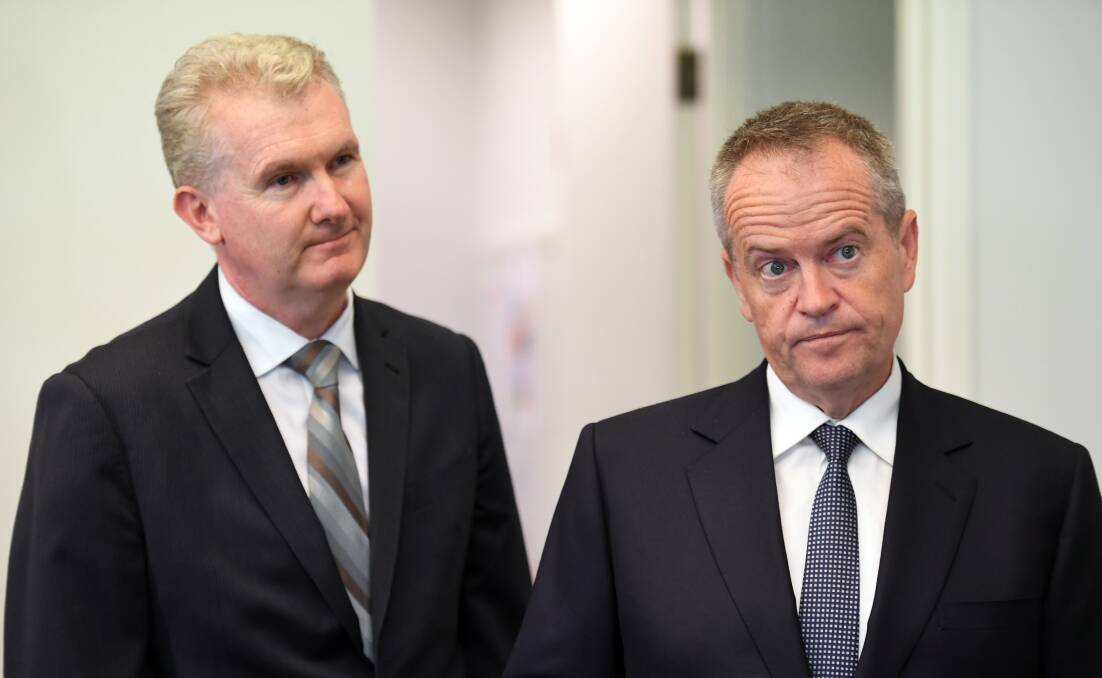
Bipartisan support for the Murray Darling Basin Plan is drying up and the upcoming federal election presents a stark choice for the future of the $13 billion reform to recover water from irrigation for the environment.
Political reactions ran hot this week following the Labor-commissioned report on the Menindee fish kills, prepared by a panel from the Australian Academy of Sciences.
Labor environment spokesman Tony Burke said the scientific evidence shows significant changes are needed to the Basin Plan including potentially a rewrite of its major feature, the water recovery target.
Federal Water Minister David Littleproud rejects Labor’s position and backs the current form of the Basin Plan, which he said was due for completion by 2024.
Mr Burke said he expected the weight of evidence in this report, and others, would prompt the Murray Darling Basin Authority to review the volume of water available to irrigation across the basin – also known as the sustainable diversion limit.
“I would be astonished if the MDBA doesn’t go with the latest scientific information available and work out if the sustainable diversion limits are indeed sustainable,” Mr Burke said.
He pledged previously to remove the government’s 1500 gigalitre cap on irrigation buybacks.
The Academy report recommended more buybacks from willing sellers of irrigation entitlement - including 70GL more in the Northern Basin.
Mr Burke backed these recommendation, but last year Labor voted with the Coalition to create new laws to reduce irrigation recovery in the Northern Basin by 70GL.
ANU professor and chairman of the Academy of Science’s panel Craig Moritz said his review found that “there isn’t enough water in the Darling system to avoid catastrophic outcomes”.
“This is partly due to the ongoing drought. However, analysis of rainfall and river flow data over decades points to excess water extraction upstream.”
The report called for changes to the legal status of northern water licences to enable new pumping embargoes on Commonwealth-owned environment water, and for a new management regime for the Menindee Lakes.
It said Menindee should be re-engineered by an environmental recovery strategy, with a minimum of 400GL held in reserve to insure against future ecological disasters like the recent series of large scale fish kills.
The reserve strategy could result in more water for the environment and less for river towns in Queensland and NSW along the Barwon-Darling River. It would also mean the Southern Basin in Victoria and NSW would likely need to supply more water to meet the eastern states’ commitments to SA.
To date, an interstate agreement has prioritised flows from Menindee to meet cross-border requirements. Putting the lake system into recovery mode would likely see more water from Hume and Dartmouth dams go to SA, making less available for irrigation.
RELATE READING
Federal Water Minister David Littleproud said it was “deeply disappointing” that Labor had politicised water reform by appointing an organisation that had a former staffer to Bill Shorten as its chief executive, and the Academy’s findings were skewed to deliver favourable outcomes for the Labor party.
“Many findings and recommendations in this document are political, not scientific. It’s a shame the Australian Academy of Science seems to have done the Labor Party’s bidding and opened itself up to claims that he who pays the piper calls the tune,” Mr Littleproud said.
“The recommendation to scrap the 1500GL cap on water buybacks is purely political. Scientists should not be concerned about how water is recovered; only how much of it goes down the system, when, and what environmental outcomes that produces.
“The Coalition continues to choose to recover water in a way which doesn’t cost jobs, and clinched crucial agreement from all states on this is December 2018.”
National Irrigators Council chief executive Steve Whan agreed with Mr Littleproud’s assertion, that drought had been the determining factor in the fish kills.
“The panel does acknowledge the impact of drought and management of Menindee lakes. But, it seems to miss the fact that the Darling’s NSW tributaries have experienced the lowest inflows in recorded history,” Mr Whan said.
“For the last 6 months of 2018 the NSW Northern Basin rivers received inflows less than 1 per cent of the average for the 10 years prior.
“We also know that for the 10 years prior 80pc of the inflows into those rivers stayed in the river and were not extracted. No irrigator has pumped anything on the Barwon Darling for more than a year.”
MDBA executive director of science and knowledge Colin Mues said the agency would consider the Academy’s findings, but argued the current form of the Basin Plan is addressing the need for more Northern Basin flows which was identified by the report.
"The key (Australian Academy of Sciences) finding, that flows in the northern rivers needs to be improved, is exactly what the Basin Plan sets out to achieve. As noted in the AAS report, this is especially challenging during drought,” Mr Mues said.
"Some of the Academy's recommendations are dealt with by actions that are already underway. For example, Basin governments are working together to plan for when the drought breaks to return sufficient flow in the Darling River.”


